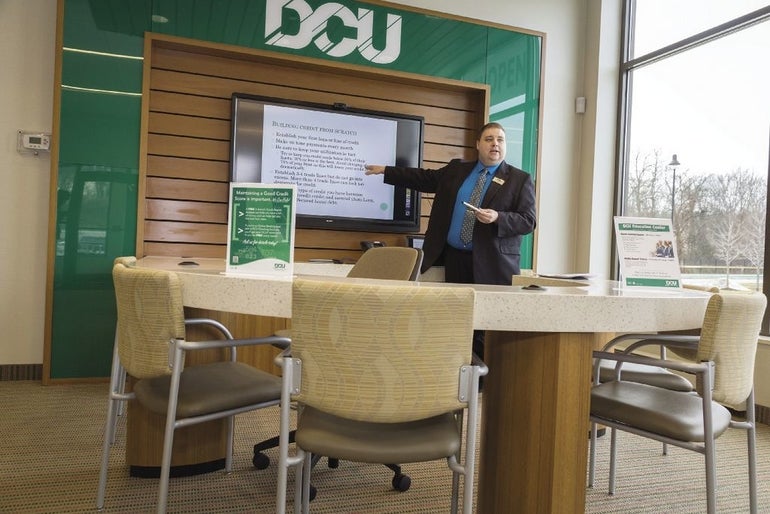Bankers call foul as rival credit unions look into public deposits
 Matt Volpini
The Worcester branch of DCU teaches financial literacy.
Matt Volpini
The Worcester branch of DCU teaches financial literacy.
Credit unions’ market share is expanding in Massachusetts, due to what they say is a great value they can offer to consumers, but the state bankers association said it is worried that growth at credit unions is unfair to banks and against the public interest, even as banks continue to hold on to a much bigger part of the state’s financial services sector.
The Massachusetts Bankers Association last month released a PolEcon Research study it paid for saying the state’s largest credit unions are growing and that their performance in low-income communities doesn’t justify the significant tax exemptions they receive.
The number of low-income designated and federally chartered credit unions have increased, the study said.
This is the latest piece in the ongoing battle over financial services between banks and credit unions and comes in the midst of a debate over the potential future role of the state’s 177 credit unions as acceptors of public deposits for cities and towns.
Credit unions, nonprofit financial institutions exempt from state and federal corporate taxes, are looking to break into the public deposits market, saying competition is good for everyone.
Bankers argue credit unions will have an unfair advantage in the market and should pay taxes if they want to get involved with local governments.
Public lending
At UniBank, a mutual bank based in Whitinsville, Justine DeNorscia is the senior vice president and director of government banking. UniBank provides public deposit services for 87 percent of Massachusetts’ 351 cities and towns, said DeNorscia, including Fitchburg, Leominster, Auburn and Worcester.
UniBank provides its municipal customers with payroll services, interest allocation funding and remote deposit services, among other things, free of charge, DeNorscia said. The bank makes its money for the line of business through deposits.
Credit unions should not be allowed to compete in this market because they don’t pay corporate taxes, she said. Additionally, federally chartered credit unions aren’t subject to the requirements of the state Community Reinvestment Act.
“Competition is healthy. We all work at it together, but to add another 100 or so entities without having to have the same tax repercussions and do the Community Reinvestment Act stuff we do, it’s unfair,” DeNorscia said.
The corporate tax exemption due to nonprofit status is part of the nature of a credit union, according to the Cooperative Credit Union Association, which services Massachusetts, Rhode Island and New Hampshire.
Federally chartered credit unions, like Marlborough-based Digital Federal Credit Union, are subject to their own regulations through the National Credit Union Administration, said Paul Gentile, president and CEO of CCUA. NCUA requirements are some of the strictest in the financial services sector, Gentile said.
“Any time there’s competition in the marketplace, it benefits consumers,” said John Lahair, marketing manager for DCU. “If an individual, business or public entity like a town or a city, they have the opportunity to choose who they do business with, we’d welcome the opportunity to be in the mix.”
Banking issues
Bankers Association President and CEO Daniel Forte said his group decided to commission a study because it noticed growth of large, federally chartered credit unions and an increase in commercial lending from the nonprofit financial institutions – and wanted to look into how the two were connected.
“We’re basically trying to connect the dots, to say, we’ve seen growth and an increase in commercial lending, how are they connected, and if they are, what do the credit unions need to do to prove that they truly are using the designation to modest means,” Forte said.
Credit union membership statewide grew by 24 percent between 2001 and 2014, with membership at the state’s largest credit unions growing 93 percent over that same time period, the study said. The state’s smaller credit unions saw a 9 percent decrease in membership over that same time period.
CCUA said the study was laden with factual errors. Credit unions are growing, but banks are growing even faster and still have a huge deposit market share advantage. Last year, credit unions in Massachusetts delivered $328 million in direct financial benefits to its members through better rates and fees, according to CCUA.
“We don’t begrudge banks because they have more powers than we do … We just have a different structure,” said Gentile. “The whole reason we exist is for the financial needs of our members.”
Banking associations in Vermont and New Hampshire have paid for similar studies, Gentile said.
Low-income designation
Community banks worry the low-income designation gives credit unions an unfair market advantage. The designation applies to credit unions where more than 50 percent of members earn 80 percent or less of the median income level of the area they serve. Over the past four years, the number of low-income designated credit unions in Massachusetts has increased from 11 in 2012 to 57 in 2016.
Part of the reason low-income designated credit unions are on the rise is because of a push from the National Credit Union Association, making eligible credit unions aware of their status and starting the paperwork process for them, said Bill Myers, director of the office of Small Credit Union Initiatives at the NCUA. The association wanted to expand the designation because it provides potential benefits to members, such as a waiver on commercial lending caps and lower interest rates.
Banks take issue with the low-income designation for a few reasons. First, credit unions are allowed to count college students towards their percentage of low-income members, which banks say makes no sense. Second, it waives commercial lending caps for credit unions, allowing them to give out business loans of any value to members.
The bankers association study claims CRA evaluations have found banks do a better job of reaching out to the low-income population than credit unions do, and that low-income designated credit unions don’t need to document their service to those communities.
“The point not to miss here is if you apply that definition of the low-income designation to the banking industry, which gets no advantage for such a designation, most of the banking industry today, without doing anything, would qualify,” Forte said.
Nationally, about 47 percent of credit union members are low-income, Myers said. It’s ridiculous not to include college students as low-income members, Gentile said.
“They have some of the [biggest] financial challenges out of the population. They’re coming out of an economy not exactly booming with high-paying jobs,” he said. “They’re hard to serve; they don’t have much income; they have a lot of debt. It’s a hard segment to serve, it’s an important segment – they’re figuring out their financial lives.”
Member business loans for credit unions are capped at 12.25 percent of their total assets, but a low-income designated credit union gets that limit waived. Those loans are for small businesses, or for people who are self-employed, Myers said. Only 6 percent of total lending done by credit unions in the U.S. last year was for businesses.
Myers said when businesses grow, they usually are referred to a bank.
“Once they become big businesses, they move to banks. That’s an ecosystem, not a description of one part of the entity trying to chew up another,” said Myers.












0 Comments